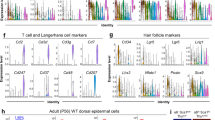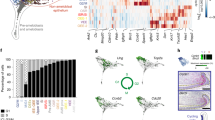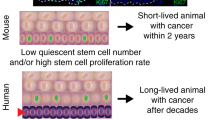Abstract
Lingual keratinized epithelial cells, which constitute the filiform papillae of the tongue, have one of the most rapid tissue turnover rates in the mammalian body and are thought to be the source of squamous cell carcinoma of the tongue. However, the mechanism of tissue maintenance and regeneration is largely unknown for these cells. Here, we show that stem cells positive for Bmi1, keratin 14 and keratin 5 are present in the base but not at the very bottom of the interpapillary pit (observed most frequently in the second or third layer (position +2 or +3) from the basal cells). Using a multicolour lineage tracing method1,2, we demonstrated that one stem cell per interpapillary pit survives long-term. The cells were shown to be unipotent stem cells for keratinized epithelial cells but not for taste bud cells, and were found to usually be in a slow-growing or resting state; however, on irradiation-induced injury, the cells rapidly entered the cell cycle and regenerated tongue epithelium. The elimination of Bmi1-positive stem cells significantly suppressed the regeneration. Taken together, these results suggest that the stem cells identified in this study are important for tissue maintenance and regeneration of the lingual epithelium.
This is a preview of subscription content, access via your institution
Access options
Subscribe to this journal
Receive 12 print issues and online access
$209.00 per year
only $17.42 per issue
Buy this article
- Purchase on Springer Link
- Instant access to full article PDF
Prices may be subject to local taxes which are calculated during checkout





Similar content being viewed by others
References
Red-Horse, K., Ueno, H., Weissman, I. L. & Krasnow, M. A. Coronary arteries form by developmental reprogramming of venous cells. Nature 464, 549–553 (2010).
Ueno, H. & Weissman, I. L. The origin and fate of yolk sac hematopoiesis: application of chimera analyses to developmental studies. Int. J. Dev. Biol. 54, 1019–1031 (2010).
Hume, W. J. & Potten, C. S. The ordered columnar structure of mouse filiform papillae. J. Cell Sci. 22, 149–160 (1976).
Luo, X., Okubo, T., Randell, S. & Hogan, B. L. Culture of endodermal stem/progenitor cells of the mouse tongue. In Vitro Cell Dev. Biol. Anim. 45, 44–54 (2009).
Okubo, T., Clark, C. & Hogan, B. L. Cell lineage mapping of taste bud cells and keratinocytes in the mouse tongue and soft palate. Stem Cells 27, 442–450 (2009).
Reya, T., Morrison, S. J., Clarke, M. F. & Weissman, I. L. Stem cells, cancer, and cancer stem cells. Nature 414, 105–111 (2001).
Li, L. & Clevers, H. Coexistence of quiescent and active adult stem cells in mammals. Science 327, 542–545 (2010).
Rinkevich, Y., Lindau, P., Ueno, H., Longaker, M. T. & Weissman, I. L. Germ-layer and lineage-restricted stem/progenitors regenerate the mouse digit tip. Nature 476, 409–413 (2011).
Zhang, H. et al. Experimental evidence showing that no mitotically active female germline progenitors exist in postnatal mouse ovaries. Proc. Natl Acad. Sci. USA 109, 12580–12585 (2012).
Rizzo, M. A., Springer, G. H., Granada, B. & Piston, D. W. An improved cyan fluorescent protein variant useful for FRET. Nat. Biotechnol. 22, 445–449 (2004).
Soriano, P. Generalized lacZ expression with the ROSA26 Cre reporter strain. Nat. Gene. 21, 70–71 (1999).
Ueno, H., Turnbull, B. B. & Weissman, I. L. Two-step oligoclonal development of male germ cells. Proc. Natl Acad. Sci. USA 106, 175–180 (2009).
Ueno, H. & Weissman, I. L. Clonal analysis of mouse development reveals a polyclonal origin for yolk sac blood islands. Dev. Cell 11, 519–533 (2006).
Sangiorgi, E. & Capecchi, M. R. Bmi1 is expressed in vivo in intestinal stem cells. Nat. Gene. 40, 915–920 (2008).
Raj, A., van den Bogaard, P., Rifkin, S. A., van Oudenaarden, A. & Tyagi, S. Imaging individual mRNA molecules using multiple singly labeled probes. Nat. Methods 5, 877–879 (2008).
Itzkovitz, S. et al. Single-molecule transcript counting of stem-cell markers in the mouse intestine. Nat. Cell Biol. 14, 106–114 (2012).
Potten, C. S., Hume, W. J., Reid, P. & Cairns, J. The segregation of DNA in epithelial stem cells. Cell 15, 899–906 (1978).
Potten, C. S. et al. Cell kinetic studies in murine ventral tongue epithelium: cell cycle progression studies using double labelling techniques. Cell Proliferation 35 (Suppl 1), 16–21 (2002).
Potten, C. S. Keratinocyte stem cells, label-retaining cells and possible genome protection mechanisms. J. Investig. Dermatol. Symp. Proc. 9, 183–195 (2004).
Stone, L. M., Finger, T. E., Tam, P. P. & Tan, S. S. Taste receptor cells arise from local epithelium, not neurogenic ectoderm. Proc. Natl Acad. Sci. USA 92, 1916–1920 (1995).
Potten, C. S. et al. Cell kinetic studies in the murine ventral tongue epithelium: mucositis induced by radiation and its protection by pretreatment with keratinocyte growth factor (KGF). Cell Proliferation 35 (Suppl 1), 32–47 (2002).
Tian, H. et al. A reserve stem cell population in small intestine renders Lgr5-positive cells dispensable. Nature 478, 255–259 (2011).
Yan, K. S. et al. The intestinal stem cell markers Bmi1 and Lgr5 identifytwo functionally distinct populations. Proc. Natl Acad. Sci. USA 109, 466–471 (2012).
Hayry, V. et al. Bmi-1 expression predicts prognosis in squamous cell carcinoma of the tongue. Br. J. Cancer 102, 892–897 (2010).
Song, L. B. et al. Bmi-1 is a novel molecular marker of nasopharyngeal carcinoma progression and immortalizes primary human nasopharyngeal epithelial cells. Cancer Res. 66, 6225–6232 (2006).
Barker, N. et al. Identification of stem cells in small intestine and colon by marker gene Lgr5. Nature 449, 1003–1007 (2007).
Harfe, B. D. et al. Evidence for an expansion-based temporal Shh gradient in specifying vertebrate digit identities. Cell 118, 517–528 (2004).
van der Flier, L.G. et al. Transcription factor achaete scute-like 2 controls intestinal stem cell fate. Cell 136, 903–912 (2009).
Acknowledgements
The authors thank P. Soriano (Mount Sinai School of Medicine, USA), R. Y. Tsien (UCSD, USA), J. Miyazaki (Osaka University, Japan), I. L. Weissman (Stanford University School of Medicine, USA) and H. Clevers (Hubrecht Institute, The Netherlands) for the materials, S. Sawada, T. Iwasaka and T. Kinoshita for generous support for the experiments, S. Maeda for statistical analyses, M. Yamamoto and N. Nishida for animal care and technical assistance, and members of the Department of Stem Cell Pathology, Kansai Medical University for helpful discussions. We acknowledge financial support from the following sources: Funding Program for Next Generation World-Leading Researchers, The Mochida Memorial Foundation, The Naito Memorial Foundation, The Cell Science Research Foundation, The Uehara Memorial Foundation, The Mitsubishi Foundation and The Yasuda Memorial Foundation to H.U.
Author information
Authors and Affiliations
Contributions
T.T. mainly performed the experiments, Y.K., Y.T., H.Y., S.O. and K.O. helped with the experiments and preparing samples. H.U. generated mice and supervised the project. T.T. and H.U. interpreted the results and wrote the manuscript.
Corresponding author
Ethics declarations
Competing interests
The authors declare no competing financial interests.
Supplementary information
Supplementary Information
Supplementary Information (PDF 770 kb)
Supplementary Table 1
Supplementary Information (XLS 32 kb)
Three-dimensional movie of the image shown in Fig. 2c, right panel.
Single Bmi1-positive stem-cell-derived areas observed 84 days after tamoxifen injection. Usually, a single Bmi1-positive stem cell supplies keratinized epithelial cells towards the tip of three (or, less frequently, four) surrounding filiform papillae. (MOV 4341 kb)
Rights and permissions
About this article
Cite this article
Tanaka, T., Komai, Y., Tokuyama, Y. et al. Identification of stem cells that maintain and regenerate lingual keratinized epithelial cells. Nat Cell Biol 15, 511–518 (2013). https://doi.org/10.1038/ncb2719
Received:
Accepted:
Published:
Issue Date:
DOI: https://doi.org/10.1038/ncb2719
This article is cited by
-
Cocktail Formula and Application Prospects for Oral and Maxillofacial Organoids
Tissue Engineering and Regenerative Medicine (2022)
-
Structure of junctional epithelium is maintained by cell populations supplied from multiple stem cells
Scientific Reports (2021)
-
Insulin Function in Peripheral Taste Organ Homeostasis
Current Oral Health Reports (2020)
-
Visualization of junctional epithelial cell replacement by oral gingival epithelial cells over a life time and after gingivectomy
Scientific Reports (2019)
-
Pharmacological inhibition of Bmi1 by PTC-209 impaired tumor growth in head neck squamous cell carcinoma
Cancer Cell International (2017)



